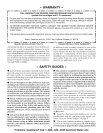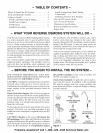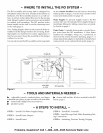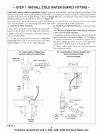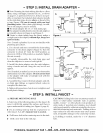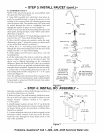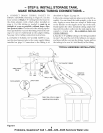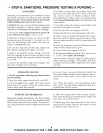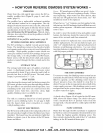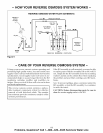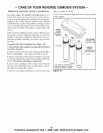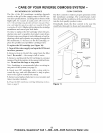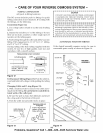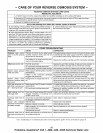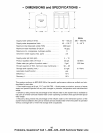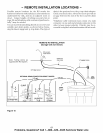
- HOW YOUR REVERSE OSMOSIS SYSTEM WORKS -
PREFILTER
Water from the cold supply pipe enters the RO as-
sembly prefilter first (Figure 8, page 8, and sche-
matic, page 11).
The prefilter has a replaceable sediment cartridge
with activated carbon in its composition. The car-
tridge (10 micron) removes sand, silt, dirt, other sedi-
ments, and up to the ppm of chlorine shown in the
specifications from the feed water (page 16). Chlo-
rine will destroy the RO membrane. Filtered, clean,
chlorine- free water flows from the prefilter, to the RO
membrane cartridge.
IMPORTANT: See pref!lter maintenance, page 12.
REVERSE OSMOSIS (RO) CARTRIDGE
The RO cartridge is a tightly wound special mem-
brane. The membrane removes the dissolved solids
and organic matter when water is forced through the
cartridge. High quality product water (about one
ounce per minute) exits the RO cartridge and goes to
the storage tank, or to the postfilter and RO faucet.
Reject water, with the dissolved solids and organic
matter, is routed through the flow control and to the
drain.
Green - RO membrane and filters are good. Amber -
Warning, filters will need replacing shortly. Filters
need replacing, when water has been drawn, after
182 days (or 750 gallons have been used). Red - RO
membrane needs to be replaced.
When the two "AA" batteries are first applied at ini-
tial start up, the LED indicator light will flash in a red,
amber, green sequence. All timers and counters are
reset to zero.
In order to reset the monitor time and gallon count
feature, the batteries should be removed for a mini-
mum of five seconds and then reinserted.
Batteries need to be replaced once a year at the time
of filter replacement. Do not mix battery types, use
only "AA" alkaline batteries, hnproper placement of
batteries could damage electronics. Use care when
inserting batteries to align them correctly in manifold
with the proper polarity.
STORAGE TANK
The storage tank holds up to 2.3 gallons of product
water. A diaphragm inside the tank keeps water
pressurized to about 30 psi, when the tank is full, to
provide fast flow to the RO faucet. The tank, when
empty, is pressurized to 5 - 7 psi.
POST FILTER
After leaving the storage tank, but before going to the
R© faucet, product water goes through the post filter.
The post filter is an activated carbon type filter. Any
remaining tastes and odors are removed from the
product water. Taste-free, odor-free, clean, high
quality drinking water is available for use.
FAUCET
The sink or countertop faucet has a hand operated
knob to access drinking water. An air-gap is built
into the faucet drain water connection to comply
with plumbing codes.
FAUCET ELECTRONICS
The RO system will monitor the total product flow of
the unit and also length of time the filters have been
installed. The faucet base has an indicator light that
flashes to inform you of the status of the R© mem-
brane and filters.
SHUTOFF ASSEMBLY
To conserve water, the drinking water system has an
automatic shutoff system. When the storage tank has
filled to capacity, and the drinking water faucet is
closed, pressure closes the shutoff to stop flow to
drain. Pressure in the storage tank is about half of the
water supply pressure. After drinking water is used,
and pressure in the system drops, the shutoff opens
to allow water flow again.
CHECK VALVE
A check valve (Figure 14) is located in the RO man-
ifold, above the center sump. The check valve pre-
vents a backward flow of product water from the
storage tank. A backward flow could rupture the RO
membrane.
FLOW CONTROL
Water flow through the R© membrane is regulated
by the flow control. It maintains the desired flow rate
to obtain the highest quality drinking water. The
flow control is located in the end of the 1 / 4" red drain
tubing, at the R© manifold drain port.
10
Problems, Questions? Call 1-800-426-9345 Kenmore Water Line



